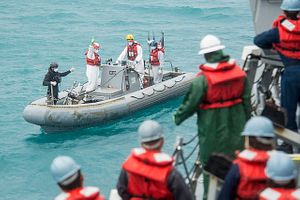For several Southeast Asian countries, 2014 ended disastrously: the Air Asia QZ8501 crash, intense flooding in eastern Malaysia and south Thailand, and the destruction caused by Typhoon Jangmi (known locally as Seniang) in the Philippines. The devastating consequences of these tragedies are still being felt today in the region as governments scramble to recover and provide relief to their affected constituents.
The tragic crash of Air Asia QZ8501 was just one of a series of disasters that struck the region in the past month. The flight was carrying 162 passengers, mostly from Indonesia. An international search party has located the crash site near the waters of the south side of Sumatra Island. As of this writing, 48 bodies had been retrieved from the waters, of which 27 have been identified.
While global attention was understandably focused on Air Asia QZ8501, there were other disasters that hit the region but received less attention. For instance, heavy rainfall in Malaysia caused flood waters to rise in the northeastern coastal towns, forcing the evacuation of more than 120,000 residents. It was reported to be the worst flooding in the eastern states in the past two decades.
The floods caught everybody by surprise, including the government which was accused of being slow to distribute relief to stranded refugees. The prime minister was forced to cut short his vacation in the United States after he was criticized for playing golf with U.S. President Barack Obama while many of his people were drowning in flood.
The opposition wanted an audit of how the disaster fund was spent following reports that many victims were unable to receive proper assistance from the government. There are also calls for an investigation to determine if the unusual flooding has been caused by the logging operations approved by local states.
The rains that unleashed the floods in Malaysia also affected the southern provinces of Thailand while the country was commemorating the tenth anniversary of the deadly 2004 tsunami. Eight provinces have been declared disaster zones due to floods. Nearly 8,000 residents have been displaced. In Narathiwat’s Tak Bai district, more than 4,000 households in 52 villages suffered from the floods.
During the same week, typhoon Jangmi battered several islands in the Visayas and Mindanao regions of the Philippines. According to authorities, Jangmi caused 66 deaths and 43 injuries. It also damaged almost 4,000 houses. As of this writing, 27 roads and 20 bridges are still not passable after they were destroyed by strong rains. The high number of casualties was attributed to complacency. Some officials claimed that many residents refused to spend the holidays in evacuation centers. But the government was also blamed for allegedly failing to give accurate information about the threat posed by Jangmi. It didn’t help that the country’s president was seen attending the wedding of two local celebrities instead of monitoring the typhoon situation in the south part of the country. Palace officials responded by assuring the public that the president was briefed about the destruction left behind by Jangmi and he has ordered the release of aid intended for storm survivors.
Some critics cited the lackluster disaster response as evidence that the government has not yet learned its lesson after the 2013 Typhoon Haiyan tragedy.
So 2014 ended badly for Southeast Asia and the situation appears even more depressing at the start of 2015. Will poor governance hamper the ability of the region to recover? At this point, one can only hope for the best.

































